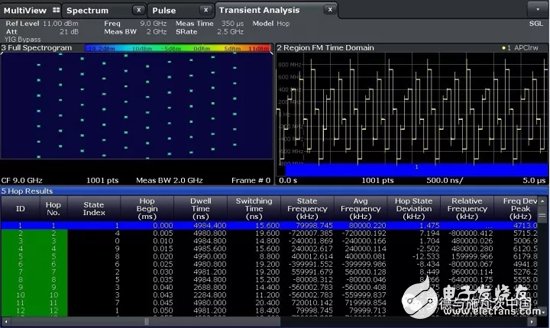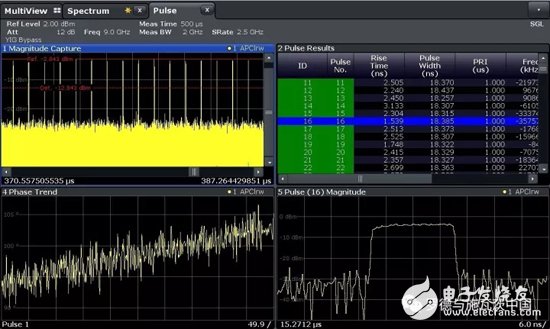Rohde & Schwarz recently introduced an R&S FSW high-end signal and spectrum analyzer with built-in 2 GHz analysis bandwidth. The R&S FSW43 and R&S FSW50 can be configured with a built-in 2GHz analysis bandwidth and are suitable for the entire frequency range of each instrument. These instruments are especially useful for measuring ultrashort pulses in frequency agile radar systems (frequency hopping) and automotive electronics UWB applications in the aerospace and defense industries.
Modern radar systems no longer transmit signals at a fixed frequency, but are capable of transmitting pulses at different frequencies and modulations. To analyze these frequency agile systems, the signal and spectrum analyzer must have a high internal analysis bandwidth to capture pulses that are accurate to the nanosecond level.
Fast frequency conversion makes the radar system more resistant to atmospheric disturbances, targeted attacks (signal blockages), and unwanted signals (interference). In order to improve the resolution, such systems can also change the modulation mode, pulse width and pulse sequence according to the target, and it is not surprising that a nanosecond pulse appears. We must test these systems and verify their performance under the dynamic conditions described above. To analyze these frequency agile systems (such as measuring the modulation quality of frequency hopping or pulse compression), you must use a large bandwidth to acquire the transmitted signal. The R&S FSW signal and spectrum analyzer provides unparalleled 2 GHz internal analysis bandwidth, which solves the problem of analyzing nanosecond rise time.
Frequency agile radar and interference transmitterSignal interference is the targeted use of interference signals to reduce the sensitivity of the enemy radar or to completely "blind". This process is mainly applied to broadband noise signals or frequency agile signals. Today's radar systems change frequency frequently, leading to a gradual decline in the effectiveness of these strategies, which makes the solution that only interferes with a particular frequency a thing of the past. The current jamming system can repeat the other party's radar signal, thus frequently changing the frequency or fast scanning frequency range. This gives them the ability to interfere with frequency agile radar systems. In the process of developing and testing the radar system and the interference system, the frequency hopping and the effectiveness of different algorithms can be analyzed in detail through broadband acquisition.
The R&S FSW with the R&S FSW-B2001 option, with a bandwidth of up to 2 GHz, is ideal for these applications. An analog to digital converter is integrated in the instrument. Data acquisition is available without the need for an additional oscilloscope. The R&S FSW-B2001 option has low input signal distortion and a high dynamic range. Its spurious-free dynamic range (SFDR) reaches 60 dBc. The importance of the above features is not only reflected in accurately determining the modulation quality of the signal, but also in effectively suppressing internally generated unwanted signals (spur signals), thereby preventing the device from recognizing it as a true reflection (false target).
The R&S FSW with the R&S FSW-K60/K60h option enables automated analysis of frequency hopping signals. This feature option detects the frequency hopping frequency, determines the offset from the target frequency, and measures how long a frequency is occupied or how long it takes for the system to switch to the next frequency. The option will automatically generate a table containing all frequency hopping frequencies and all time parameters (Figure 1). This feature option compares the data to a predefined list and lists the relevant deviations, or only detects frequency hopping within a specific tolerance. With the push of a test button, this powerful option provides detailed analysis of the frequency agile system with up to 2 GHz of bandwidth, enabling users to quickly and efficiently analyze system performance and improve the system. .

Figure 1: The upper left corner is a 2 GHz waterfall plot of the frequency agile signal. The image in the upper right corner shows the frequency of the signal in the time domain, and all the important parameters are listed in the table at the bottom. (Source: Rohde & Schwarz Munich)
Ultrashort pulse analysisThe large measurement bandwidth not only helps to characterize the frequency agile system over a large frequency range, but is also advantageous when analyzing ultrashort pulse or wideband pulse modulation. With 2 GHz bandwidth, the R&S FSW accurately measures pulse modulation and nanosecond pulse rise time.
R&S FSW's R&S FSW-K6 option is designed for detailed pulse analysis, which is especially suitable for radar applications. This option measures the amplitude, frequency and phase of the pulse and refreshes the test results in real time. The system automatically detects multiple parameters such as pulse rise and fall times, pulse repetition rate, and displays them in a table (Figure 2). This option can also display parameter trends, such as pulse repetition rates over a period of time. This feature is especially important in situations where the aircraft, in order to evade detection, sends a modified format signal similar to the enemy radar signal to deceive the enemy radar, causing it to be mistaken for the distance between the aircraft and its antenna. closer. This causes the radar to reduce its sensitivity and thus lose its target. We refer to the above situation as distance towing interference (RGPO), and in order to identify such situations, it is necessary to analyze the trend of multiple parameters over a longer period of time. Segmented acquisition pulses (that is, only pulse acquisition and time stamp processing) can help. Since the method does not preserve the data between the pulses, the number of pulses available for analysis is greatly increased, depending on the duty cycle.
For all types of intrapulse modulated signals with higher complexity than BPSK, the R&S FSW-K70 vector signal analysis option can be used for modulation analysis. This option can also be used with 2 GHz analysis bandwidth. Although this option does not provide detailed pulse analysis, it can be used to analyze the modulation quality of various digitally modulated signals.

Figure 2: Ultrashort pulse (20 nanoseconds) analysis in the time domain. The upper left is an enlarged view of the entire acquired signal; the upper right is the key parameters, including the rise time and pulse length; the lower right is the pulse amplitude of the selected pulse, and the lower left is the phase trend. (Source: Rohde & Schwarz Munich)
UWB radar
The spectrum used by UWB (Ultra Wide Band) radar systems is wider than that of conventional radar systems. The system uses ultra-short, low-power pulses with pulse widths of only a few nanoseconds. The pulse signal has a very broad spectrum similar to white noise. Therefore, it is unlikely to interfere with other applications. The UWB radar spectrum has a width of at least 25% of the transmit frequency, such as a transmit frequency of 8 GHz, and a spectral width of 2 GHz. Therefore, analysis of radar systems with a UWB band of 10.6 GHz requires an analysis bandwidth of at least 2 GHz. Currently in the automotive electronics industry, a keyless entry system uses a similar technique for detecting the distance between a key and a car.
Power Film Capacitors - Plastic Case
Polypropylene High Voltage Capacitor,Axial Film Capacitor,Axial Capacitor,SHV Capacitor
XIAN STATE IMPORT & EXPORT CORP. , https://www.shvcomponents.com